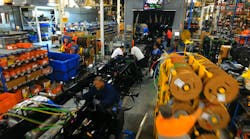Big trucks require big assembly lines. At its plant in Cleveland, N.C., Daimler Trucks North America (DTNA) produces its large-duty road tractors like Freightliner and Western Star on assembly lines that stretch more than 1,500 ft—and have more than 125 manual workstations each. Before DTNA brought in a system integrator for help, these workstations had no monitoring, control or feedback of production statuses from station to station. This situation not only contributed to substantial downtime, it also failed to give maintenance personnel the tools they needed to address those downtime issues.
Piedmont Automation, a system integrator based in Winston-Salem, N.C., recommended supervisory control and data acquisition (SCADA) and manufacturing execution system (MES) tools to give DTNA the needed insight into both real-time and historical data. Piedmont chose Inductive Automation’s open-source Ignition SCADA for visualization and Sepasoft’s MES software for overall equipment efficiency (OEE) metrics. Sepasoft is a strategic third-party module partner of Inductive Automation, with its MES software built on the Ignition platform.
“Before the addition of the SCADA platform, the assembly line had no real-time or historic feedback,” says Bob Worth, president of Piedmont Automation. “When e-stops were activated, it wasn’t readily obvious where the problem existed, and this lack of visualization contributed to substantial downtime. The previous system failed to provide the most basic tools to enable maintenance personnel to address specific downtime issues in a timely manner.”
With the plant using primarily Rockwell Automation Logix controllers for its processes, the Ignition SCADA platform uses its native Allen-Bradley drivers and SQL data bridge to move data out of the programmable logic controllers (PLCs) to the company’s OEE database, which captures critical historical data from its various production lines.
The Ignition SCADA scope includes 50,000 I/O points/tags, 50 screens, 100+ clients, 1,000 alarms and 40 Logix PLC interfaces. DTNA employs the SCADA system’s core modules, such as vision, alarm notification, SQL bridge, reporting and tag historian components. The vision module is used throughout the production areas of the plant and uses Raspberry Pi modules as clients to drive key performance indicator (KPI) monitors on the plant floor and plant management computer workstations.
With visibility into production data, plant management’s continuous improvement plan began to grow exponentially. DTNA used the SCADA system as an Andon system to notify management, maintenance and other workers of quality or process problems at the individual workstations. The centerpiece of an Andon system is local visualization with KPI monitors, signal lights and horns to indicate which workstation has a problem.
DTNA also uses the MES platform to implement consistent OEE metrics across the plant’s work cells. Piedmont Automation uses the MES’s components, scripts and database interfaces to record, process, and present production metrics.
“We developed PLC UDT [user-defined data type] tag interfaces to organize communications to the OEE module,” Worth says. “For the OEE project, Team Piedmont configured and implemented over 150 OEE cells and 4,000 OEE tags. Plant management personnel are now able to view past downtime events, drill down to pre-defined reason codes, and create ad hoc notes for particular OEE events.”
DTNA generates reports for each shift, with bar graphs for every workstation, including how many red or yellow Andon events occurred on each OEE cell and the accumulated downtime.
Depending on the type of production model a customer has, it takes on average about six months to develop an effective OEE project for the first time, according to Piedmont. “The biggest challenge with any OEE project is understanding the customer’s specific production needs and how they operate their lines,” Worth says.
With the OEE system implemented, DTNA began to recognize the ability to optimize its main assembly lines from the OEE data being collected. Piedmont worked closely with production management to organize OEE data concisely to optimize operations after reviewing production data trends. DTNA plants are now able to benchmark and compare production volumes with other DTNA assembly plant processes in real time, Piedmont noted.
For DTNA and its other U.S. trucking assembly plants, the scalable SCADA/OEE platform is pushing the company to bigger efficiencies and greater insights on its work processes.
About the Author
Grant Gerke
Digital Managing Editor

Leaders relevant to this article:
